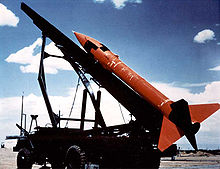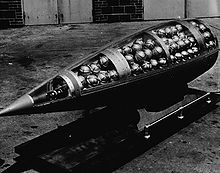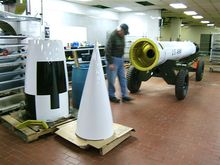- MGR-1 Honest John
-
The MGR-1 Honest John rocket was the first nuclear-capable surface-to-surface rocket in the US arsenal.[notes 1] Designated Artillery Rocket XM31, the first such rocket was tested 29 June 1951 and the first production rounds were delivered in January 1953. The designator was changed to M31 in September 1953. The first Army units received their rockets by year's end and Honest John battalions were deployed in Europe in the Spring of 1954. Alternatively, the rocket was designed to be capable of carrying an ordinary high-explosive warhead weighing 1500 pounds, even though that was not the primary purpose for which it was originally envisioned.
Contents
History and development
Developed at Redstone Arsenal, Alabama, Honest John was a large but simple fin-stabilized, unguided artillery rocket weighing 5820 pounds in its initial M-31 nuclear-armed version. Mounted on the back of a truck, HJ was aimed in much the same way as a cannon and then fired up an elevated ramp, igniting four small spin rockets as it cleared the end of the ramp. The M-31 had a range of 15.4 miles with a 20 kiloton nuclear warhead but was also capable of carrying a 1500 pound conventional warhead. Early tests exhibited more scatter on target than was acceptable when HJ was conventionally armed. Development of an upgraded Honest John, M-50, was undertaken to improve accuracy and extend range. The size of the fins was greatly reduced to eliminate “weathercocking” (the tendency of crosswinds to turn a rocket to face into the wind). Increased spin was applied to restore the positive stability margin that was lost when fin size was reduced. The improved M-50, with the smaller fins and more “rifling”, had a maximum range of 30+ miles with a scatter on target of only 250 yards, demonstrating an accuracy approaching that of tube artillery. Honest John was manufactured by the Douglas Airplane Company of Santa Monica, California. [1]
The M31 consisted of a truck-mounted, unguided, solid-fueled rocket transported in 3 separate parts. Before launch they were combined in the field, mounted on an M289 launcher and aimed and fired in about 5 minutes. The rocket was originally outfitted with a W7 variable yield nuclear warhead with a yield of up to 20 kilotons of TNT (84 TJ) and later a W31 warhead with three variants was deployed with yields of 2 kt (8.4 TJ), 10 kt (42 TJ), or 30 kt (130 TJ). There was a W31 variant of 20 kt (84 TJ) used in the Nike Hercules antiaircraft system exclusively. M-31 had a range between 5.5 and 24.8 km (3.4 and 15.4 mi).
In the 1960s Sarin nerve gas cluster munitions were also available for Honest John launch.[2]
The 2 basic versions of Honest John were:
- MGR-1A (M31) was 27ft 3in long, had an engine diameter of 22.875in, a warhead diameter of 30in (762mm), a span of 104in, weighed 5820 pounds (nuclear), and had a maximum range of 15.4 miles. The Hercules Powder Company X-202 rocket motor was 197.44in long, weighed 3937 pounds, and had 90,325 pounds average thrust.[3]
- MGR-1B (M50) was 24ft 10.53in long, had an engine diameter of 22.8in, a warhead diameter of 30in, a span of 56in, weighed 4332 pounds (nuclear), and had twice the range of the M31. The Thiokol composite propellant solid rocket motor had 150,000 pounds thrust.
Production of the MGR-1 variants finished in 1965 with a total production run of more than 7,000 rockets. Honest John’s bulbous nose and distinctive truck-mounted launch ramp made it an easily recognized symbol of the Cold War at Army bases world-wide and National Guard armories at home. Even though HJ was unguided and the first U.S. nuclear ballistic missile, it had a longer service life than all other U.S. ballistic missiles except Minuteman. The system was replaced with the MGM-52 Lance missile in 1973, but was deployed with NATO units in Europe until 1985 and National Guard units in the United States as late as 1982. Conventionally armed Honest John remained in the arsenals of Greece, Turkey and South Korea until at least the late 1990s.
By the time the last Honest Johns were withdrawn from Europe in 1985, the rocket had served with the military forces of Belgium, Britain, Canada, Denmark (non-nuclear), France, Germany, Greece, Italy, the Netherlands, Norway (non-nuclear), South Korea, Taiwan (non-nuclear), and Turkey.[4]
Support vehicles
Vehicles used with Honest John
- M33 trailer, launcher,
- M46 truck, heating and tie down unit (G744)
- M289 truck, rocket launcher, (M139 truck) (G744),
- M329 trailer, rocket transporter, (G821)
- M386 Truck, Rocket, 762mm, short launch rail, 5-ton (M139 truck)
- M405 handling unit, trailer mounted,
- M465 cart assembly, transport, 762mm rocket,
Survivors
Canada
- CFB Petawawa Military Museum CFB Petawawa, Petawawa, Ontario.
- The Central Museum of The Royal Regiment of Canadian Artillery, Shilo Manitoba
Denmark
United Kingdom
United States
- 4th Infantry Museum, 7th Cav Museum, Fort Hood, Texas
- 45th Infantry Museum, Oklahoma City, Oklahoma
- Air Force Space & Missile Museum, Cape Canaveral Air Force Station, Florida
- American Armoured Foundation, Inc. Tank & Ordnance War Memorial Museum, Danville, Virginia
- Bedford, Indiana, displayed outside a Military surplus store, at the Southwest corner of US-50/IN-37 and IN-450 (Google Maps streetview link ).
- Camp Atterbury Military Museum, Camp Atterbury, Indiana
- Carolinas Aviation Museum, Charlotte, North Carolina (Two missiles are on display - both came from the Florence Air & Missile Museum)
- Combat Air Museum, Topeka, Kansas
- Fort Lewis Museum, Fort Lewis, Washington
- Fort Sill, Oklahoma
- National Atomic Museum, Kirtland AFB, Albuquerque, New Mexico
- Rock Island Arsenal, Arsenal Island, between Iowa and Illinois
- Texas Military Forces Museum at Camp Mabry, Austin, Texas [2]
- Underwood Community Center, Underwood, Minnesota.[5]
- United States Space & Rocket Center, Huntsville, Alabama
- Yuma Proving Ground, Yuma, Arizona
Operators
- Norwegian Army (1961-65)
See also
References
- ^ The first nuclear-authorized guided missile was the MGM-5 Corporal.
- ^ Gibson, Nuclear Weapons of the United States, pp. 177-179, 1996
- ^ [1]
- ^ www.astronautix.com/articles/doulants/htm Bedard, Double Base Solid Propellants, "Major Hercules Motors", p. 3, 2009
- ^ General Dynamics, Free World Tactical Missile Systems (Pomona, CA: General Dynamics, June 1973) p.251; Jane's Weapon Systems 1987-1988 (London: Jane's, 1987) p.127.
- ^ http://www.prtelweb.com/underwood/sights.html
External links
- http://www.designation-systems.net/dusrm/r-1.html
- http://www.astronautix.com/lvs/hontjohn.htm
- Redstone Arsenal (Alabama) (includes declassified military monograph on the Honest John, chronology, pictures, and a movie of an Honest John firing) [3]
- Honest John Missile Base in Germany http://www.herzobase.org
- http://www.olive-drab.com/idphoto/id_photos_m39_missiletrk.php launchers
United States tri-service rocket designations post-1962- See also: LOCAT
- United States tri-service missile and drone designations post-1962
Types of missile By platform - Air-to-air missile (AAM)
- Air-to-surface missile (ASM)
- Surface-to-air missile (SAM)
- Surface-to-surface missile (SSM)
- Ballistic missile
- Intercontinental ballistic missile (ICBM)
- Submarine-launched ballistic missile (SLBM)
- Anti-ballistic missile (ABM)
- Intermediate-range ballistic missile (IRBM)
- Cruise missile
- Anti-ship missile (AShM)
- Anti-submarine missile
- Anti-tank missile (ATGM)
- Anti-satellite weapon (ASAT)
- Air-launched ballistic missile
- Anti-ship ballistic missile (ASBM)
By guidance Lists - List of missiles
- List of missiles by country
- List of military rockets
Categories:- Unguided nuclear rockets of the United States
- Cold War missiles of the United States
- Surface-to-surface missiles
- Nuclear artillery
- Cold War weapons of the United States
- Nuclear weapons of the United States
- Cluster bombs
Wikimedia Foundation. 2010.



